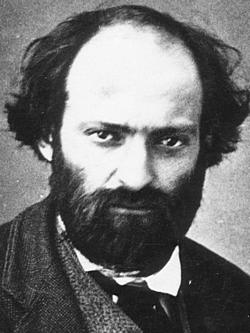
Born: 19 January 1839, Aix-en-Provence, France
Died: 22 October (aged 67)
Period: Impressionism, Post-Impressionism
The Life of Paul Cézanne
Paul Cézanne was a French artist and Post-Impressionist painter whose work laid the foundations for the transition from the 19th-century conception of artistic endeavor to a new and radically different world of art in the 20th century. Cézanne’s often repetitive, exploratory brushstrokes are highly characteristic and clearly recognizable. He used planes of color and small brushstrokes that build up to form complex fields, a method that directly influenced the development of Cubism and modern art as we know it.
Early Life Born in Aix-en-Provence in the South of France, Cézanne was the son of a wealthy banker, which afforded him financial security throughout his life. Despite his father’s wishes for him to pursue a career in law, Cézanne was drawn to art from a young age. He moved to Paris in 1861, after several attempts to satisfy his father’s career expectations, to pursue his artistic development.
Artistic Career and Development In Paris, Cézanne became part of the Impressionist movement through his friendship with Camille Pissarro, an influence that can be seen in his early works. However, Cézanne gradually developed a distinct style that sought to bring structure and a sense of order to the Impressionist approach to capturing natural scenes. He was known for working tirelessly to capture the essence of his subjects, often painting the same scene repeatedly to perfect his representation.
Cézanne’s work was not widely appreciated during his early career, and he struggled with rejection from the traditional art establishment. His submissions to the Paris Salon were repeatedly refused, and his participation in the first Impressionist exhibition in 1874 attracted critical scorn. However, his commitment to his vision and technique remained unwavering.
Later Years and Legacy By the turn of the century, Cézanne’s work began to gain recognition and acclaim. His approach to building form with color and his analytical approach to nature influenced the art world profoundly. Cézanne’s exploration of geometric simplification and optical phenomena inspired future artists to experiment with abstract forms and led to the emergence of Cubism, heralded by artists like Pablo Picasso and Georges Braque.
Cézanne returned to Provence in his later years, where he continued to work until his death in 1906. His last period was marked by intense productivity and some of his most celebrated works, including his studies of Mont Sainte-Victoire and the “Bathers” series.
Today, Cézanne is recognized as one of the most influential artists of the 19th century, with his work serving as a bridge between Impressionism and the modern art movements of the 20th century. His dedication to capturing the complexity of the natural world and the subtleties of human perception changed the direction of modern art, earning him the title of “the father of us all” among the avant-garde artists of the early 1900s.
Paul Cézanne’s Notable Works
Paul Cézanne, a pivotal figure in the transition to modern art, left a profound legacy through his distinct approach to painting. His exploration of form, color, and composition opened new pathways for the development of 20th-century art. Here are ten of Cézanne’s most famous and influential works:
- “The Bathers” (Les Grandes Baigneuses, c. 1894–1905) – This series, particularly the largest version housed in the Philadelphia Museum of Art, showcases Cézanne’s mastery in composing complex figure scenes, integrating human forms into a harmonious, natural landscape. It’s a key precursor to modernist explorations of the figure.
- “Mont Sainte-Victoire” series (c. 1882–1906) – Cézanne’s multiple studies of Mont Sainte-Victoire, seen from various angles and at different times of the day, underscore his preoccupation with the permanence of nature and the act of perception. These paintings are celebrated for their structural composition and brushwork.
- “The Card Players” series (c. 1890–1895) – Comprising five paintings, this series is admired for its depiction of Provencal peasants engrossed in their game, reflecting Cézanne’s interest in capturing the essence of his subjects through a reduction of form.
- “Still Life with Basket of Apples” (c. 1890–1894) – This still life is renowned for its play with perspective and space, challenging traditional perceptions and showcasing Cézanne’s innovative approach to common subjects.
- “Boy in a Red Waistcoat” (c. 1888–1890) – This portrait is notable for its intense study of color and form, capturing the personality of the young subject through a sophisticated use of hue and brushstroke.
- “The Black Marble Clock” (c. 1869-1871) – An early work that highlights Cézanne’s interest in the tactile qualities of objects and their spatial relationships, setting the stage for his later explorations in still life compositions.
- “Madame Cézanne in a Yellow Chair” (c. 1888-1890) – Part of a series of portraits of his wife, Hortense Fiquet, this painting exemplifies Cézanne’s ability to convey the sitter’s presence through a careful balance of color and form.
- “The Basket of Apples” (c. 1893) – Another celebrated still life, this work is emblematic of Cézanne’s technique of constructing a scene through color patches, creating a dynamic interplay of forms.
- “Jas de Bouffan” series (c. 1874–1885) – These landscapes of Cézanne’s family estate are pivotal for understanding his evolving approach to capturing the essence of the natural world, emphasizing the geometric structure underlying the observed reality.
- “View of Auvers-sur-Oise” (c. 1874-1875) – This landscape painting, from Cézanne’s Impressionist period, showcases his early interest in capturing the atmospheric effects and the vibrant light of the natural environment, a theme he would continue to explore throughout his career.
Cézanne’s oeuvre is a testament to his innovative spirit, with each work contributing to his legacy as a foundational figure in the development of modern art. His meticulous study of nature, objects, and figures through paint laid the groundwork for the cubist movements and fundamentally altered the course of artistic expression in the 20th century.